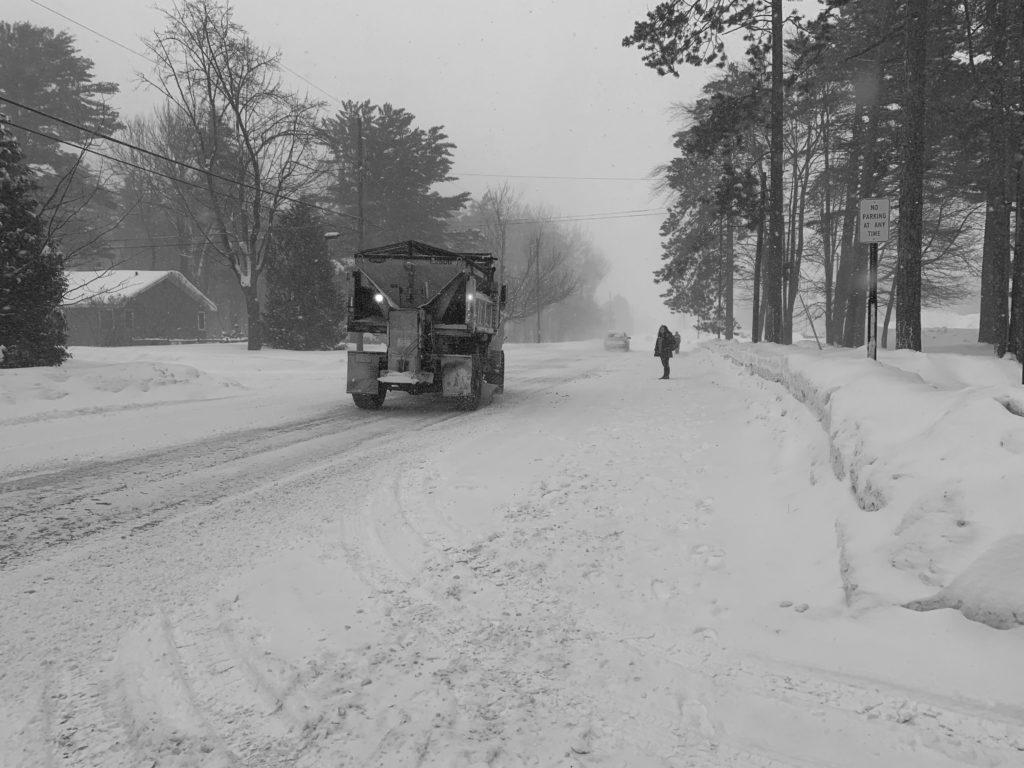Marquette is now the snowiest city in America, according to the National Weather Service, and with the presence of many recent snowstorms, snow removal services throughout the city are
staying busy.
Although the volume of snow this winter is probably not much worse than other winters, the speed at which the snow accumulates becomes a problem, Director of Public Works Scott Cambensy said. It becomes difficult to find storage for all of the snow, Cambensy added.
“Now, if you look out your window, the banks are getting pretty high, and that’s when it becomes more problematic,” Cambensy said. “When we’re not plowing snow, we’re trying to remove snow from the banks.”
On Tuesday, Feb. 12, daily maximum precipitation and snowfall records were set. Daily precipitation totaled 1.30 inches up from the previous record of 1.28 inches set in 1984. Daily snowfall totaled 16.5 inches in roughly 15 hours, breaking the previous record of 13.5 inches set in 1965.
The plowers of Marquette have eight designated routes, and if needed, plowers on these routes can be pulled over into working the major streets for heavier snowfall. The hills off of Washington Street, school zones and the main route to the hospital are what they focus on before the neighborhoods and local streets, and lastly the dead ends.
Plowing the routes usually takes a total of eight to 10 hours, Cambensy said.
There are three different shifts that operators follow for snow removal – the first shift is from 6:30 a.m. to 2:30 p.m., a second shift 2:30 to 10:30 p.m. and another shift from 10:30 p.m. to 6:30 a.m., which is only needed to deal with more intense snowfalls, like what the area has seen in recent weeks.
“We have coverage around the clock right now,” Cambensy said.
If drivers are on the side of the street and see a plow coming, try and move the car out of the way either into a driveway or another location, because it makes the snow removal process run much smoother, Cambensy said.
“If you don’t have to park on the street when we’re going through a snow event, it certainly helps us out tremendously,” he added.
Over on campus, the NMU Grounds Department is busy plowing over 20 miles of sidewalks, 16 miles of road and 70 acres of parking lots and driveways, Grounds Supervisor Andy Smith said.
Without any prolonged warm up, all the snow that we have received since mid-December has really stacked up on campus,” Smith said.
Smith and his team had to spend extra time pushing back snow piles to create room for the future high-volume snowstorms, he said. Storms that only bring 1 to 2 inches of snow require constant scraping, sanding and salt- ing, Smith added. The bitter cold from the “polar vortex” inhibits the utility of salt, and windy conditions cause drifts, making it difficult for snow removal, he said.
“We need to have campus open by about 7:30 each morning. The crew starts at 4 a.m. and works non-stop until we are able to clear the roads, major parking lots and sidewalks,” Smith said. “After mid-morning, we work on clean- ing up the rest of campus.”
So far, the grounds department has plowed over 100 inches of snow.
NMU has five loaders with plows, three plow trucks and a mini loader with either a plow or snowblower attachment. The department has a staff of eight operators to clear all of campus.
“The heavier the snow, the less of it we can plow in one pass. Five to six inches of heavy snow pushes the limit of some of our equipment,” Smith said.
In relation to other years, the grounds department has had an easier time removing snow from residential parking lots, because the word is getting out and students are realizing the importance of moving their vehicles for a cleaner, safer parking lot, Smith said.
Smith gave a number of suggestions to students that make plowing campus easier. Pay attention to the residential lot plowing schedule, only park in designated parking spots and give snow removal crews plenty of room to work. Plow operators also appreciate a thank you, he added. Lastly, pedestrians need to walk carefully, Smith said.
“The recent ice storm followed by heavy snow and continued cold weather has left a hidden lay- er of ice below the snow, which is difficult to see and for us to scrape clean,” Smith said.






























